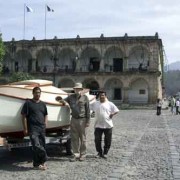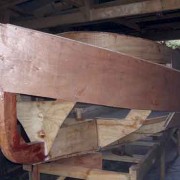Not Your Traditional Artesanía

The author and two La Antigua cabinet makers turned boat builders next to the catboat at central park, La Antigua
Written by Ira Lewis
Local craftsmen recruited to build a classic wooden catboat
I’ve sailed all my life, and for years I’ve wanted to build a boat. I have the time. OK, so do it. But I’m not a good carpenter, and I don’t have proper tools. I live in La Antigua, where there are no professional boat builders. So do it anyway.
Over the years I have dealt with some excellent cabinet-makers in Guatemala—and with some wood butchers. I felt that by contracting a truly fine cabinet-maker and working daily in his shop, I could overcome my shortcomings.
I would draft the unfamiliar pieces and supervise the form, eyeballing the shape, while his tools and experience would compensate for my ham-handed carpentry. As the boat progressed, I was very happy to find that my assumption was correct.
La Antigua has no lakes, no big rivers—hardly a place to build boats. But, residents of this mountain-locked, dry-land city have used the extraordinary skills of local artisans to do just that.
Several years ago, a fiberglass factory in Santa Lucía Milpas Altas produced many things, including rowboats and surfboards.
Just recently, M. Pierre Turlin, a French sailor and artist who works mostly in wood and glass, launched his 37-foot sloop in Río Dulce. He designed the boat with a centerboard and shallow draft for use in the cays. It has many other innovative features, which make it a safe, comfortable boat for extended cruising. The yacht was built here in La Antigua with local helpers who had no experience in boat building. The hull is steel, but the deck and interior are done in the beautifully finished wood for which Pierre is well known.
A 20-foot outboard launch is under construction by Sr. Elmer Monzón, who has a fiberglass shop in Jocotenango. He is also laying up a peddle-powered boat, which will incorporate a transmission.
And now, my classic wooden boat, built here, is almost ready to launch. This mini-cruiser is a 15-foot catboat, a design developed in Cape Cod, Massachusetts around 1850 for fishing. Since catboats have a wide beam, usually almost half their length, this is not a small dinghy. She will happily carry six adults day sailing and has bunk flats in the cuddy cabin, where two can sleep. Another distinguishing feature of catboats is the large, single sail set on a mast very near the bow.
She is being built in the cabinet-makers shop of Sr. Jorge Samayoa Paniagua on Calle Rubio, behind the Hotel Santo Domingo. I discussed my idea with him, explaining that I needed a place to build, proper tools and one or more skilled carpenters to cut the pieces to my patterns and help me assemble them. I showed him the scale model I’d built of cardboard (4 cm to 1 foot) and explained the method of building. He replied, saying essentially, “If it’s built of wood, we can do it.” We made a hand-shake contract.
Sr. David Ramírez was assigned as my full-time helper. He and Sr. Samayoa constructed a sturdy, completely level building platform which became the base line for all measurements. The bottom plank with a rocker of 7 inches at the bow and 8.5 inches at the stern was tacked to the platform with dry-wall screws. The centerboard slot was precut, and the reinforcing logs on each side helped maintain the correct curve in the bottom.
The stem, bulkheads and stern were carefully aligned and epoxied in place. The boat is built of marine plywood using the “tack and tape” method. Joints are epoxied together and reinforced with two strips of fiberglass tape. This gives a very strong joint with no screws to rust inside the wood over the years.
Some longitudinal bulkheads and the centerboard trunk added between the bulkheads gave more rigidity than the sheer clamps, where the deck joins the hull, were put on. The three wide planks of each side of the hull were attached, the deck laid and the cabin and coaming built. Ah! It’s a boat —not quite.
David and I had worked four months to get to this point. To speed things up I added Sr. Francisco Vásquez Ramírez, “Chico,” to the crew to help finish the seemingly endless details involved in making a sailboat sail.
We built the mast from a bent aluminum spinnaker pole salvaged from a larger yacht. After trimming it to the right length we sheathed it in a 3/4-inch layer of ash, a strong, light wood, to achieve the proper diameter and for added strength.
The myriad details, including fiberglassing the exterior of the hull, building a centerboard, the rudder, rigging and painting have taken longer then the basic construction of the boat.
The fittings of mild steel and brass were custom made by local craftsmen. They were curious about making pieces for a boat, but the items made were of good workmanship.
By launch date, I was very glad I chose to build my boat here in La Antigua instead of trying to supervise construction in a boat-building area like Atitlán or Puerto Barrios involving a long commute. The fine artisans of La Antigua can, very well, adapt their skills to build a sturdy, well-finished boat.
- The three artisans most involved in building the boat, Alejandro Morales, Francisco “Chico” Vásquez and David Ramírez, pose just before the boat leaves the shop
- The 37 foot steel yacht built by M. Pierre Turlin in La Antigua Guatemala.
- The author and two La Antigua cabinet makers turned boat builders next to the catboat at central park, La Antigua
- “Chico” adds trim to the centerboard trunk
- The first topsides plank, the cabin sides and part of the first bilge planks are fastened
- The boat leaves the shop
- The bottom plank with the centerboard trunk stiffeners in place being screwed to the building platform by David Ramírez







Hello! Is it possible you could send me Pierre Turlin’s email? I am a boat captain from the caribbean and lover of wooden boats and am in guatemala for another month. My email is mnotpk@gmail.com